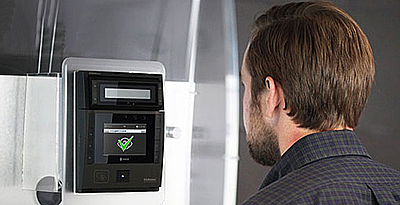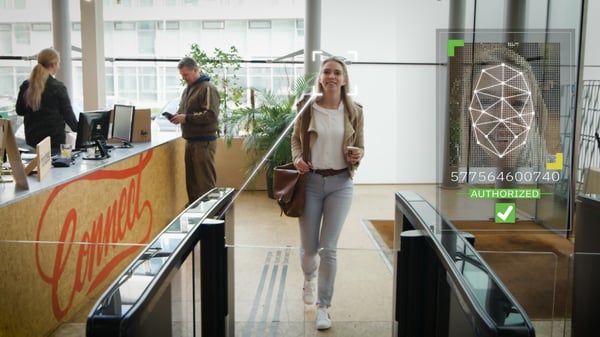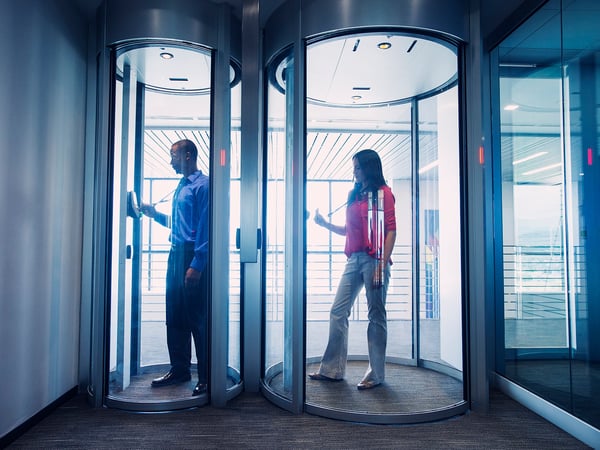The pairing of biometric technology with security entrances has been gaining momentum for more than a decade, and understandably so. The marriage has made it possible to swiftly verify identity, while at the same time, address the risk of unauthorized entry from tailgating. But the deployment of biometrics and security entrances is advancing to a different phase as organizations look for improved access control solutions to negate lingering health concerns post-COVID-19.
As business and government prepare to rebound from the most lethal virus pandemic in more than a century, security experts seem to be in agreement that access control and security entrances will involve enhanced biometric solutions along with a move away from contact-based security and access control systems to a more germless or friction-free process. Fortunately, that plays right into the growing trend being adopted by mid-sized to enterprise-level access control systems of marrying turnstiles and security revolving doors with advanced biometrics.
 The Challenges of Integrating Biometrics with Security Turnstiles
The Challenges of Integrating Biometrics with Security Turnstiles
Controlling access at the entry has always been a challenge for security professionals, especially when it comes to incorporating security entrances like turnstiles and security revolving doors into their plans. Slow throughput, aesthetics, cost, and security were previous issues of concerns. One of the nation’s leading security consultants, Ray Bernard, President of Ray Bernard Consulting, admits that innovative vendors and smart integration have overcome almost every one of these challenges.
“It used to be almost impossible to achieve a ‘welcoming openness’ to a lobby without bypass-proof entry/exit lanes. Aesthetically acceptable breach-proof floor-to-ceiling barriers had been cost-prohibitive and were only made technically feasible recently by using glass etching and coating technologies,” Bernard says. “Security revolving doors have been the best solution to date, but the slower throughput achieved when integrated with biometrics often did not provide sufficient throughput per door for many lobbies.”
But Bernard says most obstacles have been negated by pairing biometrics with AI-based pedestrian-differentiation technology and it appears to be the right approach to strong entrance control, adding that this system can involve expanding the “zone” in which access control is functioning beyond just the lanes themselves. Bernard explains:
“Some forms of biometrics like facial recognition and gait recognition, can start working from a distance and be fast enough to use sensors located at each turnstile. But they require that the person walk straight in from a few feet away, not – for example – walk sideways in front of the turnstiles then make a quick turn into a lane. Another variation on this theme is to have automatic, free-flowing revolving doors on the building envelope (which reduce unwanted air infiltration) and use optical turnstiles for access control inside. This is appropriate for 'public use' entrances that include visitors or others who may not be registered for access. In such a case, facial recognition can be performed at the revolving door, and the person can be tracked via overhead cameras and granted access through the turnstiles. This is just another example of a workable design using today’s advanced security entrance devices and emerging biometrics.”

Biometrics Must Adapt and Become Less Invasive
The widespread use of biometrics is not without its legal obstacles, especially when implementing facial recognition. The legislative landscape across the U.S. regarding facial deployment and its use has been inconsistent at best, and legally confusing at its worst. Beyond the strategic installation and application challenges faced are those of transparency and privacy of data. Other technologies such as iris recognition and hand waving devices are less invasive and usually more palatable for integrating with security entrances. Both are also touchless technologies that facilitate high throughput, are easy to implement and are cost effective.
Understanding the type of access control system and security entrance it must integrate with is the overriding factor for success. For example, biometrics may or may not be appropriate for use with a tripod and full height turnstile since these entrances deter unauthorized entry but are unable to outright prevent it. They lack sensors that can alert security staff if a person climbs over or crawls under the tripod turnstile, or if two people piggyback through a full height turnstile. Depending on the security entrance and its location, the expense of a biometric may be partially offset by simply using RFI card-reader technology or QR code readers. Optical turnstiles and security revolving doors offer higher levels of security that can better accommodate biometrics because they prevent unauthorized entry and have sensors that will alarm to alert staff.
 As discussions on biometrics and security entrances evolve over the next year, the public’s concerns related to the lingering legacy of the coronavirus will continue to influence technology discussions. As the impact of business and government shutdowns are absorbed and renewed business operational procedures are implemented, the paradigm shift to contactless modes of access and identity will undoubtedly shape the industry’s future.
As discussions on biometrics and security entrances evolve over the next year, the public’s concerns related to the lingering legacy of the coronavirus will continue to influence technology discussions. As the impact of business and government shutdowns are absorbed and renewed business operational procedures are implemented, the paradigm shift to contactless modes of access and identity will undoubtedly shape the industry’s future.

